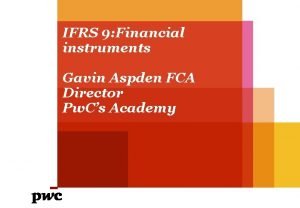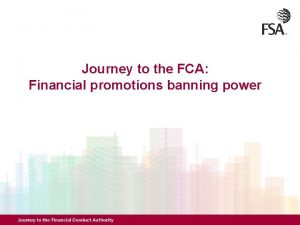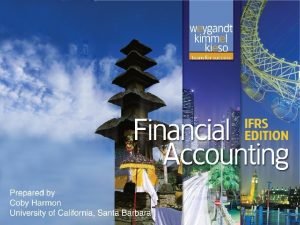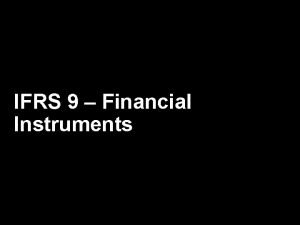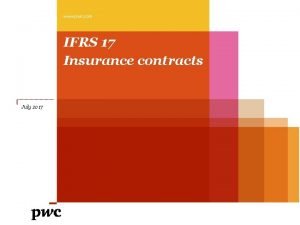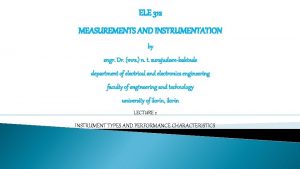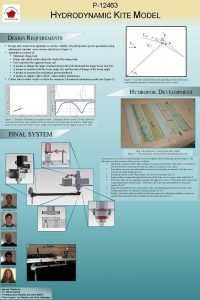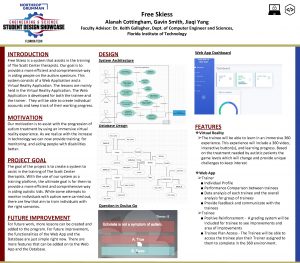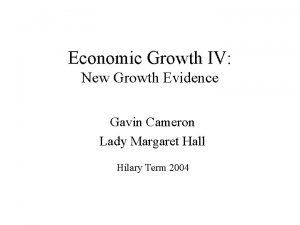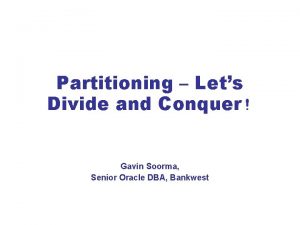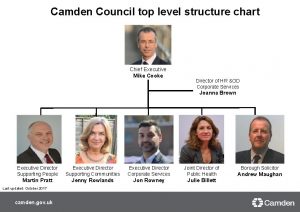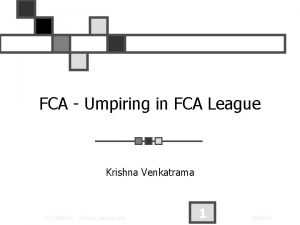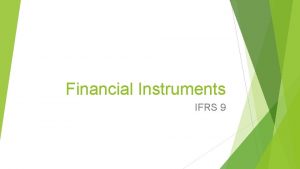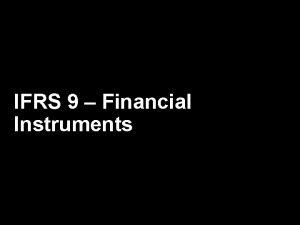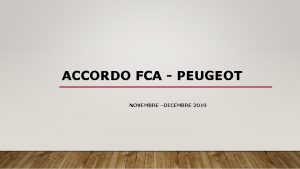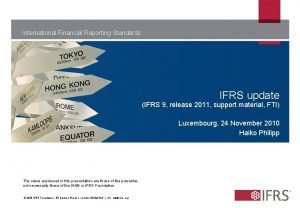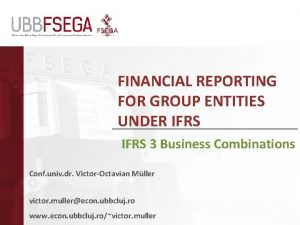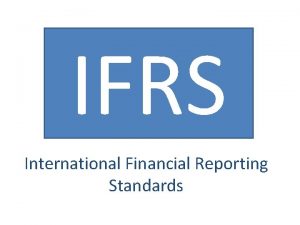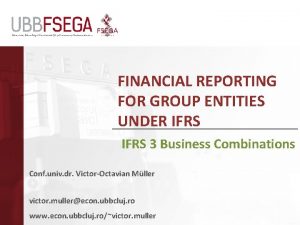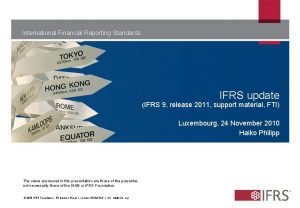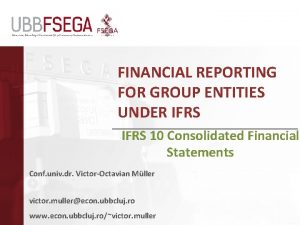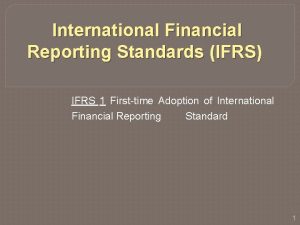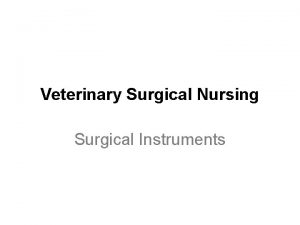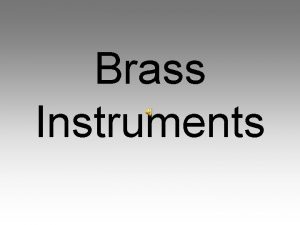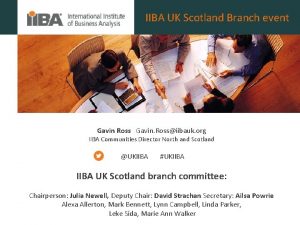IFRS 9 Financial instruments Gavin Aspden FCA Director





















- Slides: 21

IFRS 9: Financial instruments Gavin Aspden FCA Director Pw. C’s Academy

Transition When does IFRS 9 become mandatory? • Annual periods beginning on or after 1 January 2018 • Early adoption permitted but - Cannot early adopt earlier editions of IFRS 9 (since 1 February 2015) • Full retrospective application on adoption but - Restatement of comparatives is not required but is permitted if it can be done without the benefit of hindsight - If comparatives are not restated the opening balance of its retained earnings should be adjusted Pw. C’s Academy

IFRS 9 Financial assets – new model summary Contractual cash flow characteristics + model Business test All other instruments Equities, derivatives & some hybrid contracts Amortised cost Fair value option (Original exposure draft) Accounting mismatches only Fair value through P&L Option to take gains & losses to OCI for equities No recycling No bifurcation Reclassification required where business model changes Pw. C’s Academy

IFRS 9 Financial assets – new model summary Contractual cash flow characteristics + model Business test All other instruments Equities, derivatives & some hybrid contracts Hold to collect Amortised cost Hold to collect and sell Fair value through OCI Fair value through P&L Fair value option Accounting mismatches only Option to take gains & losses to OCI for equities No recycling No bifurcation Reclassification required where business model changes Pw. C’s Academy

IFRS 9 Financial liabilities Retain IAS 39 measurement requirements Held for trading Fair value through P&L Vanilla liabilities Amortised cost Hybrid instruments Bifurcation Maintain fair value option – but with one amendment regarding ‘own credit risk’ Pw. C’s Academy

IFRS 9 Impairment Incurred loss model • Currently used by IAS 39 • Credit losses are recognised only if an event has occurred that has a negative effect on future cash flows & that effect can be reliably estimated • An entity is not permitted to consider the effects of future expected losses Pw. C’s Academy The challenge • ‘Financial meltdown’ • ‘Too big to fail’ • ‘Cliff effect’ • ‘Risk taking’ • ‘Unrealised v realised profits’ • ‘Complex disclosures’ • ‘G 20, Governments and politics’ • ‘Bonus culture’ Expected loss model • Proposed way forwards • Requires an entity to make an ongoing assessment of expected credit losses • Will require earlier recognition of credit losses in many cases

IFRS 9 IASB’s approach v FASB’s approach US GAAP – Day one loss model IFRS – stages model Fundamental difference in views ‘Complexity v ‘Simplicity’ ‘Prudence’ v ‘Reality’ Issue became a ‘deal breaker’ for US GAAP and IFRS convergence process in many ways Pw. C’s Academy

IFRS 9 How will impairment provisions change? Analysts at Barclays have calculated how 27 of Europe’s biggest banks would fare under new global rules governing how much lenders should set aside for potential bad loans. They found that the rules would trigger an increase of about 34 per cent in loan loss provisions across the group, as well as lower bank valuations and more volatile earnings”. “Spain’s Caixa, Italy’s UBI and the UK’s Standard Chartered are the most affected by the change in the IFRS 9 rules. Caixa’s common equity tier one ratio would fall by about 1. 7 per cent as a result of the higher loan losses triggered by the rules, Barclays said, while Standard Chartered’s and UBI’s would fall by about 1. 3 per cent. ” Pw. C’s Academy

IFRS 9 Scope exclusions Financial assets credit impaired on initial recognition • Includes both originated and purchased credit-impaired assets • Outside of scope of the above model • Use credit adjusted effective interest rate • No day 1 allowance balance • No day 1 impairment loss recognised • Allowance balance represents changes in lifetime loss expectations • Consistent with IAS 39 (AG 5) Trade receivables without a significant financing component • Practical expedient to enable entities to calculate losses using certain current practices eg, group receivables by age and applying historical loss rates • Implied application to non-financial services entities • Recognition of full lifetime expected loss on a matrix model basis Pw. C’s Academy

IFRS 9 Expected loss model… Stage 2 • On initial recognition • Interest revenue calculated on gross carrying amount • Lifetime losses from default inside 12 months weighted by probability of default in 12 months • If more than insignificant deterioration in credit quality & likelihood of loss event reasonably possible • Interest revenue calculated on gross carrying amount • Lifetime expected loss allowance Stage 3 Stage 1 Performing Pw. C’s Academy • If deteriorate to credit-impaired • Interest revenue calculated on net carrying amount • Lifetime expected loss allowance Underperforming Non-performing

IFRS 9 Low credit risk If the credit risk is determined to be low at the reporting date • Impairment can be measured using 12 -month ECL • Presumption that no significant increase in credit risk has occurred There is a low risk of default Borrower has strong capacity to meet obligations in the short term Adverse changes in economic or business conditions in the longer term wont necessarily reduce ability to fulfil obligations • Risk is evaluated without consideration of collateral • Not considered low risk just through comparison to entity’s other instruments or the jurisdiction in which the entity operates • Internal ratings are permitted providing consistent with a global rating definition of ‘investment grade’ • If no longer ‘low risk’ it does not automatically move to Stage 2 Pw. C’s Academy

IFRS 9 Significant increase in credit risk The following indicators were identified: • Change in internal price indicators of credit risk - Change in credit spread, rates, terms, collateral, guarantees or covenants if issued now • Changes in market indicators of credit risk - Change in credit spread, credit default swap price, fair values below amortised cost value, changes in the prices of borrowers other instruments • Change in externally or internally derived credit rating of borrower • Change in general economic or market conditions, regulatory or technology environment of the borrower • Change in actual or expected performance of the borrower • Values of underlying collateral • Changes in guarantee quality • Change in the loan documentation • Change in credit risk management Pw. C’s Academy

IFRS 9 Significant increase in credit risk The following indicators were identified: • Change in internal price indicators of credit risk - Change in credit spread, rates, terms, collateral, guarantees or covenants if issued now Rebuttable • Changes in market indicators of Presumption credit risk - Change in credit spread, credit default swap fair values below amortised cost value, changes in the Credit risk hasprice, increased prices of borrowers other instruments significantly when • Change in externally or internally derived credit rating contractual payments are of borrower more than 30 conditions, days pastregulatory due • Change in general economic or market or technology environment of the borrower • Change in actual or expected performance of the borrower • Values of underlying collateral • Changes in guarantee quality • Change in the loan documentation • Change in credit risk management Pw. C’s Academy

Measurement of expected credit losses Expected credit losses are: • a probability weighted estimate • the present value of all cash shortfalls • discounted at the original effective interest rate • over the expected life of the financial instrument Pw. C’s Academy An entity should measure in a way that reflects: – An unbiased and probability weighted amount that is determined by evaluating a range of possible outcomes; – The time value of money; and – Reasonable and supportable information that is available without undue cost or effort at the reporting date about past events, current conditions and forecasts of future economic conditions

Disclosures relating to ECL Qualitative • Inputs, assumptions and estimation techniques used - For estimating ECL - To determine significant increases in credit risk and default - To determine credit impaired assets • Write off policies, modification policies and collateral Pw. C’s Academy Quantitative • Reconciliation of opening to closing amounts showing key drivers of change - Loss allowance - Gross amounts • Gross amounts by credit risk grade • Write offs, recoveries and modifications

IFRS 9 Challenges Strategic • Impact on Capital • Impact on earnings stability and other KPIs • Managing stakeholders’ and market expectations Tactical • • • Pw. C’s Academy Define indicators and thresholds for level migration, especially between levels 1 and 2 Define and identify key information to bridge current models to multi -year EL requirements Align with peer group Operational • Data availability • Data quality • Financial reporting • Management reporting • Regulatory reporting • Impact on IT systems (model on model)

Hedge Accounting- How will corporates benefit from IFRS 9? Simplification of hedge accounting and brings it in line with an entity’s risk management strategy Effectiveness testing is now more relaxed Main benefits relate to hedge accounting! Removes many of the provisions that made it difficult to apply hedge accounting under IAS 39 Exposures permitted to be hedged have expanded. For eg risk components of non financial items Better accounting treatment available for options Pw. C’s Academy

IAS 39 IFRS 9 Hedging Hedged item An asset, liability, firm commitment, highly probable forecast transaction or net investment in a foreign operation that exposes the entity to risks of changes in fair value or future cash flows and is designated as being hedged Hedging instrument Designated derivative or other financial asset or liability whose fair value or cash flows are expected to offset changes in the fair value of the designated hedged item Most often a derivative Gains and losses on hedged items and hedged instruments can be accounted for under hedge accounting rules provided the hedging relationship is formally designated & documented and expected to be highly effective. Pw. C’s Academy

IAS 39 IFRS 9 Hedging types Fair Value Hedge of fair value of a recognised asset or liability or unrecognised firm commitment Hedged item & hedging instrument re-measured to fair value via profit or loss Cash Flow Hedge of cash flow volatility associated with a recognised asset or liability or highly probable forecast transaction Effective gain or loss on hedging instrument to equity until hedged item affects profit or loss Outcome is that gains & losses on hedged item and hedged instrument matched in P/L in same period Pw. C’s Academy

IFRS 9 for corporates Pw. C’s Academy

IFRS 9: Financial instruments Gavin Aspden FCA Director Pw. C’s Academy
 Gavin aspden
Gavin aspden Fca financial promotions
Fca financial promotions Financial accounting ifrs 4th edition chapter 12
Financial accounting ifrs 4th edition chapter 12 Financial assets ifrs
Financial assets ifrs Pwc
Pwc Examples of null type instruments
Examples of null type instruments Pressure measuring devices
Pressure measuring devices Gavin is designing a kite
Gavin is designing a kite Pc gavin smith
Pc gavin smith Gavin greenfield
Gavin greenfield Gavin cotter
Gavin cotter Gavin smith wren academy
Gavin smith wren academy Gavin cameron
Gavin cameron Gavin giovannoni
Gavin giovannoni Gavin cameron
Gavin cameron Partitioning
Partitioning Camden council structure chart
Camden council structure chart Gavin greenfield
Gavin greenfield China market research group
China market research group Gavin swann
Gavin swann Gavin davies imperial
Gavin davies imperial Wendy gavin
Wendy gavin
